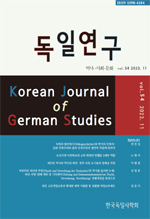제2차 세계대전 중 도시 공습은 연합국에게나 독일에게 동일하게 작용하는 동기들에 의해 시행되었다. 이를 통해 보복, 경제적 경쟁력의 절멸, 그리고 문화적 정체성의 파괴를 관철하려는 것이다. 그것은 역으로 종전 이후 재건의 과정에서 무엇이 복구되어야 하는지를 미리 보여준다. 재건은 평화 구축과 경제적 회생을 향한 수고로 진행될 것이며, 그리고 와해된 정체성을 다시 세우는 작업을 의미할 것이었다. 여기에서 1945년 이후 독일의 복구가 ‘재건의 역사’인 동시에 ‘역사의 재건’으로 전개되는 것임을 주목하게 된다. 파괴된 도시의 복구에서 가장 시급해 보였던 것은 사회적 주거문제의 해결이었지만, 그와 동시에 도시의 재건은 그 지역 도시민들의 문화적 정체성을 시각적으로 회복하는 과정이기도 했다. 서양 근대사의 본질로서 민족국가의 형성이 지체되었던 독일인들에게 오랫동안 정체성 함양의 중심 역할을 했던 것은 도시였다. 추상적인 민족의식보다도 독일인들을 결속시킬 수 있는 구심점은 도시 한복판의 물화된 건축공간이 제공하는 가시성이었다. 그리고 이제 문화 지방의 경계로서 도시가 갖는 시각적 정체성이 전쟁의 파괴로 와해되자 도시계획적 재건은 곧 정체성의 재건 작업으로서 정치적이며 역사적인 의미로 구현되어야 했다. 전후 독일의 새 출발을 ‘재건의 역사’와 ‘역사의 재건’의 관점에서 볼 때 그것은 만족할만한 인적 청산 없이 나치 이념이 더 이상 작동할 여지가 없는 건축공간의 재건에서 각 도시의 특성에 따라 지역적인 정체성 ─민족적인 정체성이 아니라─ 형성의 과정으로 전개되었다고 할 수 있다.
During the Second World War, air raids were conducted due to the same motivations for both the Allied Forces and Germany. They aimed at using this for retaliation, annihilating each other’s economic competitiveness, and destroying cultural identities. In reverse, this shows in advance what must be restored during the post-war reconstruction process. Reconstruction is carried out as efforts towards building peace and toward economic restoration, and as a work to rebuild the disintegrated identity. Here, we focus on the fact that the restoration of Germany since 1945 was carried out as both the ‘history of reconstruction’ and ‘reconstruction of history’. What appeared to the most pressing issue in restoring a destroyed city was solving the social residential issue, but at the same time, the reconstruction of a city was a process of visually restoring the cultural identity of the urban population of those regions. As the essence of modern history of the West, cities played a pivotal role over a long period for developing identity of Germans, whose formation as a nation-state was delayed. The core element that was able to unite Germans was not an abstract sense of national awareness, but the visibility provided by a materialized architectural space in the middle of the city. And when the visual identity possessed by the city as a border of cultural provinces was destroyed by war, urban planning reconstruction was embodied as a reconstruction work of identity with political and historical meaning. When viewing the new beginning of post-war Germany from the perspective of ‘history of reconstruction’ and ‘reconstruction of history’, it can be said that satisfactory reconstruction of architectural space without any chance for Nazi ideals to be activated again developed through the course of forming regional identity - and not national identity - according to the features of city without eradicating humans.
Ⅰ. 머리말
Ⅱ. 전후 재건을 위한 도시계획의 수립
Ⅲ. 복원적 재건
Ⅳ. 신축과 역사적 조정
Ⅴ. 맺음말
